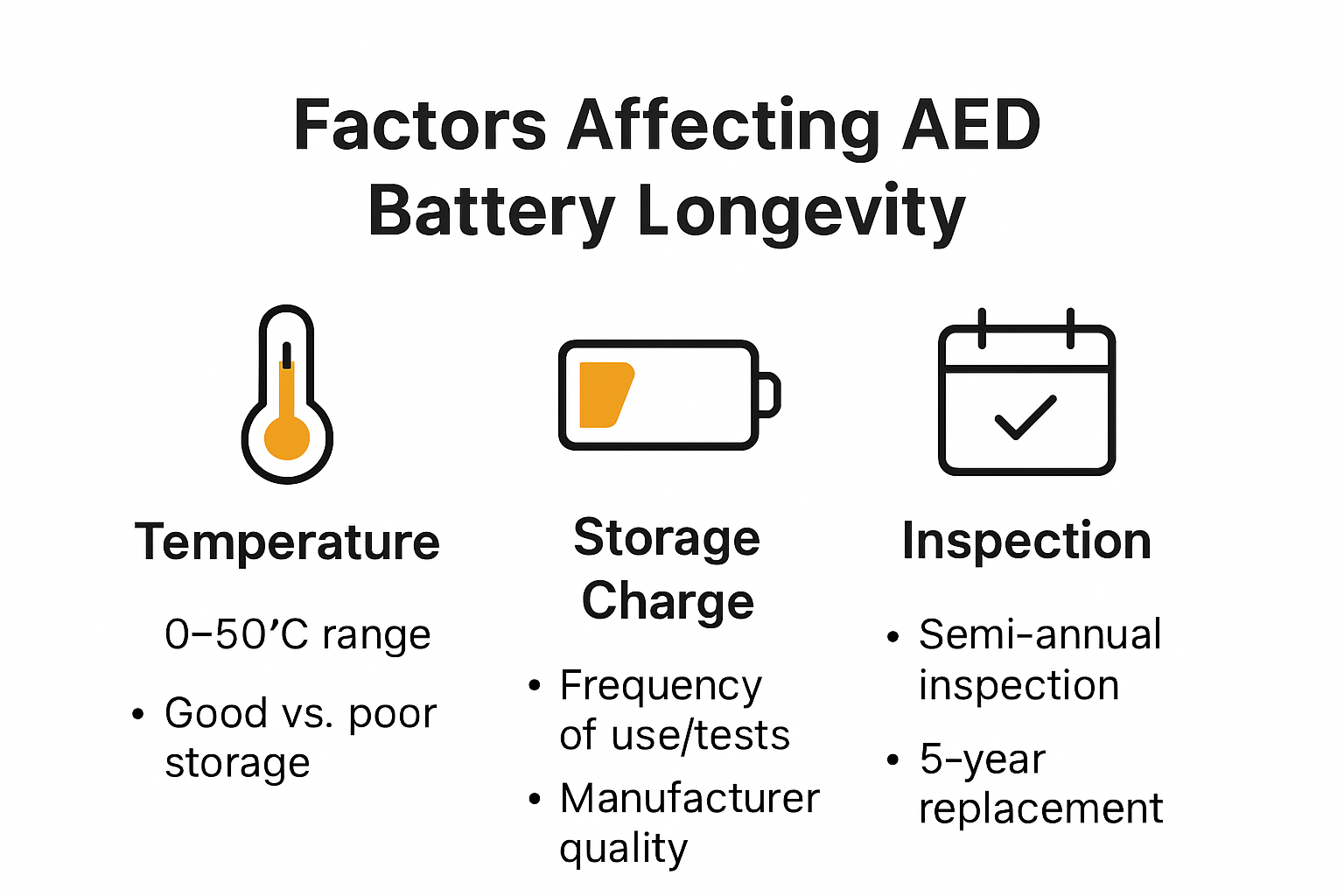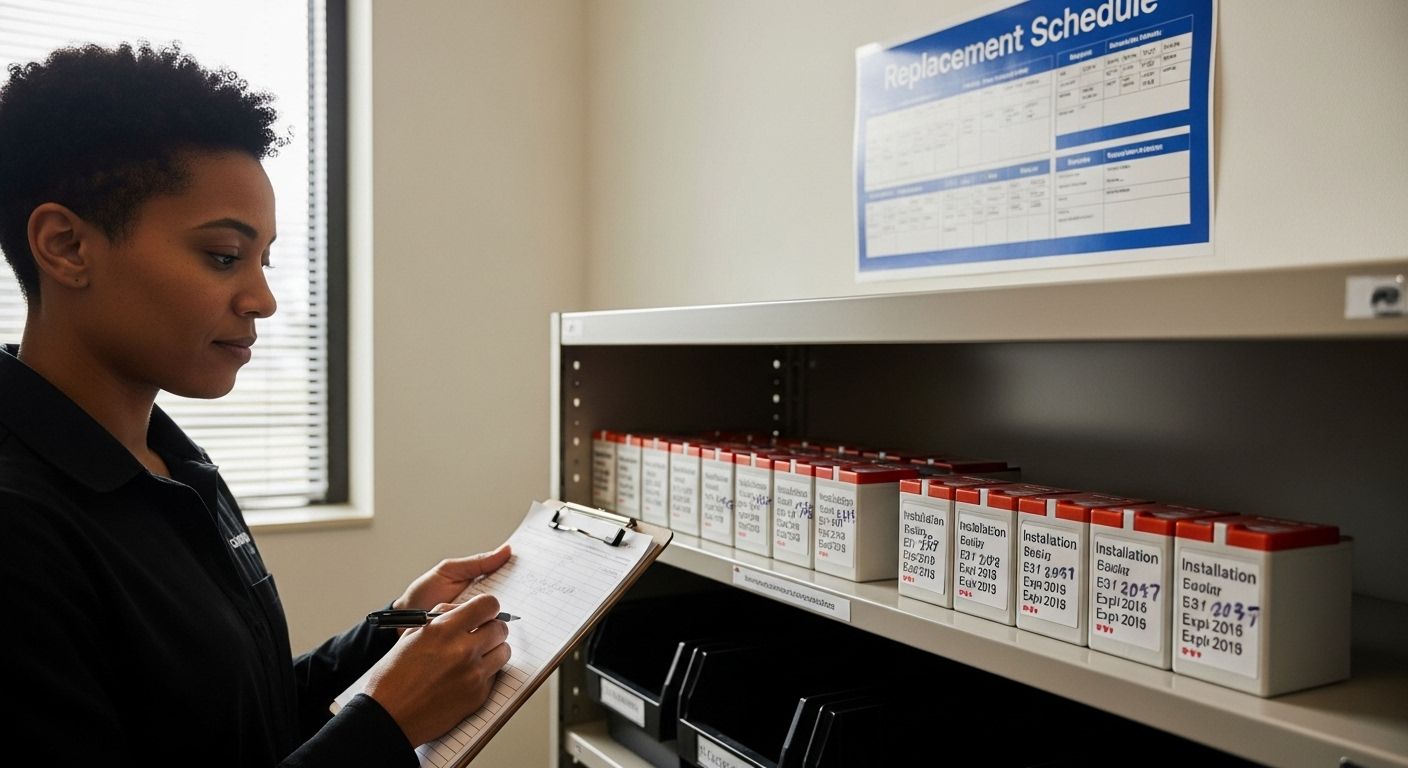
Organisations depend on AEDs to deliver a life-saving shock during cardiac emergencies, yet battery reliability is often overlooked. Here is something most do not realise. One study found that 15 percent of public AEDs were not ready for use—mainly due to battery or accessibility problems. It turns out that a battery’s lifespan depends as much on regular checks and storage as it does on technology, and neglecting this simple routine could put lives at unnecessary risk.
Table of Contents
- Understanding AED Battery Life Expectancy
- Factors That Affect AED Battery Longevity
- How To Check And Maintain Your AED Batteries
- Frequently Asked Questions About AED Batteries
Quick Summary
| Takeaway | Explanation |
|---|---|
| Regular inspections are essential for AEDs. | Consistent visual and functional checks prevent battery failure and ensure readiness in emergencies. Monthly inspections are recommended for optimal performance. |
| Track battery installation and expiration dates. | Organizations should maintain detailed logs of battery installation dates and expiration to plan timely replacements effectively. |
| Environmental conditions impact battery life. | Storing AED batteries in controlled temperatures (10°C to 25°C) prevents premature degradation and optimises performance. |
| Use manufacturer-approved batteries only. | Non-approved batteries can compromise AED performance and may void warranties. Always choose high-quality components to ensure reliability. |
| Routine maintenance training is crucial. | Staff should be trained in battery management protocols to enhance emergency preparedness and ensure proper inspections are performed consistently. |
Understanding AED Battery Life Expectancy
AED battery life represents a critical component of emergency preparedness, directly influencing the device’s ability to deliver life-saving intervention during cardiac emergencies. Understanding the nuanced aspects of battery performance and maintenance can mean the difference between a successful rescue and a potential tragedy.
The Critical Timeframe of AED Battery Performance
AED batteries are not designed for indefinite use. Purdue University’s Fire Department recommends proactive maintenance through quarterly self-audits to ensure devices remain ‘rescue ready’. Most professional-grade AED batteries have a standard operational lifespan of approximately four years, with manufacturers providing specific guidelines for replacement.
The battery status is typically indicated through a colour-coded light system. These indicators provide a quick visual reference for battery health:
To provide a quick visual overview of AED battery status indicators, the following table summarises the meaning of each indicator and the suggested action:
| Indicator Light | Battery Capacity | Timeframe | Action Required |
|---|---|---|---|
| Four Green Lights | 100% | ~4 years remaining | No action needed |
| Three Green Lights | 75% | ~3 years remaining | Monitor, plan for replacement |
| Two Green Lights | 50% | ~2 years remaining | Schedule future replacement |
| One Green Light | 25% | ≤1 year remaining | Replace soon |
| Red Light | 0% | Immediate | Replace battery immediately |
- Four Green Lights: 100% battery capacity (4 years)
- Three Green Lights: 75% battery capacity (3 years)
- Two Green Lights: 50% battery capacity (2 years)
- One Green Light: 25% battery capacity (1 year or less)
- Red Light: Immediate replacement required
Manufacturer Guidelines and Inspection Protocols
Georgia Institute of Technology’s Environmental Health & Safety department emphasizes the importance of understanding battery expiration dates. Most AED batteries have a four-year expiration period from their manufacturing date. This means organisations must be diligent in tracking not just the battery’s current status, but its original manufacturing date.
Regular inspections are paramount. Scouting America highlights that modern AEDs often perform periodic self-tests and can emit an alarm if a potential issue is detected. However, organisations should not solely rely on automated systems and must implement a structured inspection regime.
Key inspection protocols include:
- Visual Examination: Check for physical damage or corrosion
- Date Verification: Confirm the battery’s manufacturing and expiration dates
- Functional Testing: Ensure the device responds correctly during self-diagnostic checks
- Replacement Planning: Schedule battery replacements before expiration
The consequences of neglecting battery maintenance can be severe. An AED with a depleted or expired battery might fail during a critical moment, potentially compromising an individual’s chance of survival during a cardiac emergency. Organisations must view battery maintenance not as an optional task, but as a fundamental aspect of their emergency response strategy.
Proactive management involves creating a systematic tracking system, training staff on battery inspection protocols, and budgeting for regular replacements. By treating AED batteries with the same level of importance as the devices themselves, organisations can ensure their life-saving equipment remains fully operational and ready to respond at a moment’s notice.
Factors That Affect AED Battery Longevity
AED battery longevity is not a simple matter of time but a complex interplay of environmental, storage, and usage conditions that can significantly impact performance and reliability. Understanding these critical factors is essential for organisations seeking to maintain their life-saving equipment in optimal condition.
Environmental and Storage Conditions
The Association for the Advancement of Medical Instrumentation (AAMI) provides crucial insights into battery performance, particularly for lithium-ion batteries commonly used in AEDs. Their research reveals that battery storage conditions play a pivotal role in determining overall longevity. Optimal battery storage requires maintaining the charge between 30% to 50% capacity, which helps mitigate age-related capacity degradation.
Temperature is another critical environmental factor. Extreme temperatures both hot and cold can dramatically reduce battery performance and lifespan. Most manufacturers recommend storing AED batteries in environments with consistent temperatures between 10°C and 25°C (50°F to 77°F). Humidity, direct sunlight, and proximity to heat sources can also accelerate battery deterioration.
Usage Patterns and Maintenance Frequency
A comprehensive five-year study published in the National Library of Medicine highlighted that battery readiness is not just about storage but also about consistent maintenance. The study revealed that 15% of public AEDs were not ready for use, with battery and accessibility issues being primary concerns.
Frequent self-tests and periodic maintenance can impact battery performance. While these tests are crucial for ensuring device readiness, they also consume battery power. Organisations must balance the need for regular checks with the potential drain on battery life. Most modern AEDs are designed to perform minimal energy-consuming self-diagnostics, but the cumulative effect over years can be significant.

Battery Chemistry and Manufacturing Quality
The inherent quality of the battery itself plays a substantial role in determining its longevity. Lithium-ion batteries, while advanced, have natural degradation characteristics. Purdue University’s Fire Department recommends marking the installation date and tracking battery performance through indicator lights.
Manufacturing quality variations can lead to differences in battery performance. Reputable manufacturers invest in high-quality battery cells and protective circuitry that can extend battery life. Cheaper or lower-quality batteries might degrade faster, potentially compromising the AED’s reliability during a critical emergency.
Proper battery management involves more than just replacement. Regular partial charging every two months can help maintain battery health. Organisations should develop a systematic approach to battery tracking, including detailed logs of installation dates, performance indicators, and replacement schedules.
Ultimately, AED battery longevity is a multifaceted issue requiring proactive management. By understanding and mitigating environmental, usage, and manufacturing factors, organisations can ensure their AEDs remain reliable life-saving tools, ready to respond when every second counts.
How to Check and Maintain Your AED Batteries
Maintaining AED batteries requires a systematic and proactive approach to ensure these critical life-saving devices remain fully operational. Research from the National Institutes of Health emphasizes that battery failure represents a significant risk factor in potential resuscitation scenarios, underscoring the importance of rigorous maintenance protocols.
Regular Visual and Functional Inspections
Conducting comprehensive visual and functional inspections forms the cornerstone of effective AED battery maintenance. These inspections should be performed monthly, with more detailed quarterly assessments. During visual checks, examine the battery for signs of physical damage, corrosion, or wear. Look for any cracks, discoloration, or deformation that might compromise battery integrity.
Modern AEDs typically feature built-in self-diagnostic systems that provide critical information about battery status. Pay close attention to indicator lights and status messages. Most devices will display clear warnings when battery replacement becomes necessary. Organisations should train designated personnel to understand and respond to these indicators promptly.
Documentation and Tracking System
Implementing a robust documentation system is crucial for systematic battery management. Create a detailed log that tracks:
- Battery Installation Date: Record the exact date of battery installation
- Manufacturer Details: Note specific battery model and serial number
- Inspection Dates: Log every visual and functional inspection
- Performance Indicators: Document any warnings or status changes
- Replacement Schedule: Plan and track battery replacement intervals
Digital tracking systems can enhance this process, providing automated reminders and comprehensive historical records. Some organisations use specialised asset management software to monitor AED battery lifecycles efficiently.
Professional Maintenance and Replacement Strategies
While internal checks are essential, periodic professional maintenance remains critical. Consider scheduling annual professional inspections with qualified technicians who can perform comprehensive diagnostics beyond routine visual checks. These experts can assess battery performance using specialized equipment and identify potential issues that might not be immediately apparent.
Battery replacement should follow manufacturer recommendations, typically every three to four years. However, this timeline can vary based on specific device models and usage patterns. Always consult the manufacturer’s guidelines for precise replacement intervals. When replacing batteries, ensure you use manufacturer-approved components to maintain device reliability.
Additional best practices include storing replacement batteries in appropriate conditions temperature-controlled environments away from direct sunlight and extreme temperatures. Keep spare batteries readily accessible and clearly label them with purchase and expected replacement dates.

Remember that AED battery maintenance is not just a technical requirement but a critical responsibility. A well-maintained battery can mean the difference between a successful intervention and a potentially tragic outcome during a cardiac emergency. By implementing comprehensive maintenance protocols, organisations demonstrate their commitment to public safety and emergency preparedness.
Frequently Asked Questions About AED Batteries
AED batteries are complex components that generate numerous questions among healthcare professionals, safety managers, and organisations responsible for emergency preparedness. Understanding these critical details can significantly enhance device reliability and effectiveness.
Common Battery Performance Queries
Purdue University’s Fire Department provides insights into the most frequently asked questions regarding AED battery performance. One prevalent question is about the expected battery lifespan. Most professional-grade AED batteries have a standard operational period of approximately four years, with a clear visual indicator system to track battery health.
Another common inquiry relates to battery storage and maintenance. Organisations often wonder about the best practices for preserving battery integrity. Experts recommend storing batteries in temperature-controlled environments, avoiding extreme temperatures, and maintaining them at 30-50% charge when not in active use. Periodic partial charging every two months can help maintain battery performance and prevent complete discharge.
Replacement and Maintenance Concerns
Scouting America addresses critical maintenance questions that organisations frequently encounter. A key concern is understanding when to replace batteries. While the standard recommendation is every four years, this can vary based on specific device models, usage patterns, and environmental conditions.
Maintenance responsibilities often raise questions about inspection frequency. Vanderbilt University’s Resuscitation Program recommends different inspection protocols for various settings:
The following table outlines the recommended inspection frequency for AEDs in different organisational settings, helping ensure devices remain ready for use:
| Setting/Area | Inspection Frequency |
|---|---|
| Clinical Areas | Daily inspections |
| Public Areas | Weekly checks |
| Organisational Settings | Monthly comprehensive reviews |
Regular checks ensure AED reliability and timely battery replacement according to the specific environment.
- Clinical Areas: Daily inspections required
- Public Areas: Weekly checks recommended
- Organisational Settings: Monthly comprehensive reviews
Particularly important is understanding the difference between battery self-tests and manual inspections. While modern AEDs perform automated diagnostics, these should not replace thorough human-conducted examinations.
Technical and Practical Battery Management
Organisations frequently inquire about the financial and practical aspects of battery management. The cost of replacement batteries, the potential risks of using alternative or non-manufacturer-approved batteries, and the training required for proper battery maintenance are common concerns.
Experts consistently advise using only manufacturer-approved batteries to ensure device compatibility and reliability. Generic or third-party batteries might compromise the AED’s performance and potentially void warranty provisions. Additionally, staff training should include not just battery replacement procedures but also understanding warning indicators and the critical nature of maintaining emergency equipment.
It is crucial to recognise that AED battery management is not merely a technical task but a fundamental aspect of emergency preparedness. Each battery check, each replacement, and each inspection represents a commitment to potentially saving a life. By addressing these questions proactively, organisations demonstrate their dedication to maintaining life-saving equipment in optimal condition.
Remember, when it comes to AED batteries, there are no insignificant questions. Every inquiry contributes to a more comprehensive understanding of these critical devices and enhances overall emergency response capabilities.
Frequently Asked Questions
What is the typical lifespan of an AED battery?
Most professional-grade AED batteries have a standard operational lifespan of approximately four years, subject to specific manufacturer guidelines.
How can I ensure my AED battery remains functional?
Regular visual and functional inspections, maintaining proper storage conditions, and using only manufacturer-approved batteries are essential for keeping your AED battery functional.
What factors can affect the longevity of an AED battery?
Environmental conditions such as temperature extremes, humidity, and improper storage can significantly impact the longevity of an AED battery. Additionally, usage patterns and the quality of battery manufacturing play important roles.
How often should AED batteries be replaced?
It is recommended to replace AED batteries every four years; however, this may vary based on the specific device models, usage patterns, and environmental conditions. Always consult the manufacturer’s guidelines for precise replacement timelines.
Ready for a Battery You Can Rely On When Every Second Counts?
Have you ever worried that your AED might let you down at the worst possible moment? Many organisations discover too late that outdated or unchecked batteries can leave their defibrillator powerless during an emergency. As highlighted in this article, missed inspections, incorrect storage, or unapproved battery types put lives at risk and threaten your whole emergency preparedness plan.

If you want complete confidence that your defibrillator will work every time, visit Defib Experts for dependable AED batteries, high-quality replacement kits, and thorough servicing solutions. Explore trusted hospital-grade products and find expert support to help you manage battery tracking and maintenance routines for your entire team. Protect every heartbeat in your care and take action today by visiting Defib Experts. Your next lifesaving decision starts here.
